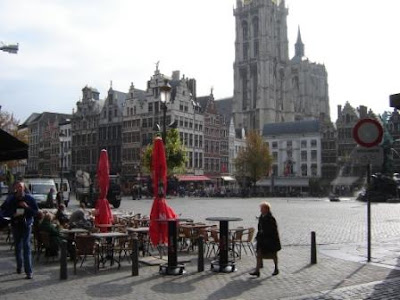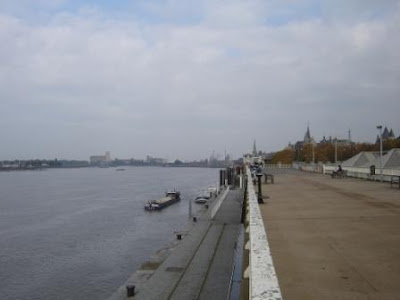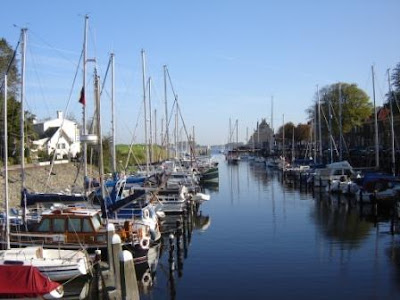This took place on the Tuesday of my trip to Zeeland and it seemed a shame not to head down to Belgium while I was near the border. Lieselot strongly recommended Antwerp, so I went for it.
View Larger Map
Getting there was a bit of a hassle as we were sandwiched against the sea in a relatively unpopulated region (populated for Canada, not for Holland). It took a combination of buses and trains, and lets just say that the connections did not work so well. In one case, the bus got there two minutes before the train left, and after running my ass off to make the switch I literally saw the train pull away as I started to purchase the ticket for it.
Stupidly, I hadn't really prepared for a trip either. I didn't have my train discount card, my passport, any guide books, or, most importantly, my backpack. Lieselot was kind enough to lend me one, which I'm quite sure is the uncoolest backpack ever made by anybody in the history of the world.

Regardless, I made it. It was funny; as I left the last train station in Holland I was reading my book, and when I looked up I immediately knew I was in a different country, even though there were only sparse houses around.
My first impression of Belgium from a train window was that it had substantially less character than the only European country I'd seen so far.
However, this is what it looks like when you get off the train at Antwerp Central station.

The train station is in a gorgeous old building and it's a massive five storey structure with trains arriving on all levels. The immediate photo below gives a good sense of the vertical size of the place.


The streets were about as lively as you could wish for on a kinda-chilly-but-at-least-the-skies-are-sort-of-clear Tuesday afternoon. Antwerp is a beautiful city.

I stopped a few blocks in to sit and consult my guide and map I picked up from the train station for the pleasantly inexpensive price of 1 Euro.
This was interesting. For those who don't follow Belgian politics (I can't fathom that anyone reading this doesn't, but just to be sure), the country is in a perpetual state of governance turmoil. Half the country is Flemish--Dutch, more or less--and half is French. The power between the two halves swings like a pendulem over time periods, but it's currently Flanders, the Flemish region, that has the advantage in economic and population strength.
Think about it this way; for all the political games played between Quebec and Ottawa, Quebec only has about 1/5 of the population of Canada (a ratio which is decreasing). Imagine if they had half, and you get the idea of the daily life of a Belgian politician.
Currently, no party in the country has a clear majority and they have been unable to agree on enough common ground to be able to work together. Over the summer it was seriously speculated that Belgium might break up into two different countries. This threat seems to have passed, but only for the short term.
Why was this interesting while I was reading my guide book? Well, Antwerp is in Flanders, and Flanders was mentioned throughout the guide book--much more often than the conspicious phrase "federal Belgium". Even in the tourist brochures, an attentive eye will catch hints of the tensions in the country.
But anyway. On with the show.





Antwerp has had an on-and-off history as an "important" city, but it's boom periods have come primarily because of the size of its port--the second largest in Europe. (The first largest? Rotterdam.)
Yeah, yeah, you say. Where's the really impressive stuff? Well, this church will knock your socks off.
It's called the Onze-Lieve-Vrouwekathedraal, or Cathedral Of Our Lady, and its spire, at 123 meters, is the highest one in the "Low Countries" (Netherlands, Belgium, Luxemberg). I wondered if it was larger than Dom Tower in Utrecht--it is, by 20 meters.

Construction on the church begain in the 14th century and stopped in the 16th. I say 'stopped' because it was never really completed the way it was planned.





Nearby is the city hall, a very nice building.
In front is a fountain that was built as a tribute to the legend of mystical creatures that created Antwerp. It's a pleasant fountain until you look closely and notice that most of the water streams are coming from severed arteries, such as the detached hand held up high.

Along the waterfront is a castle that's been converted into a museum.
This statue is also referencing the legend of the city, in this case looking suspiciously like a giant urinating on a bunch of a peasants.

Notables and runner-ups:






So that's my first Belgium experience. This blog will slowly start to orbit outside of its Netherlands axis as time goes on.














































